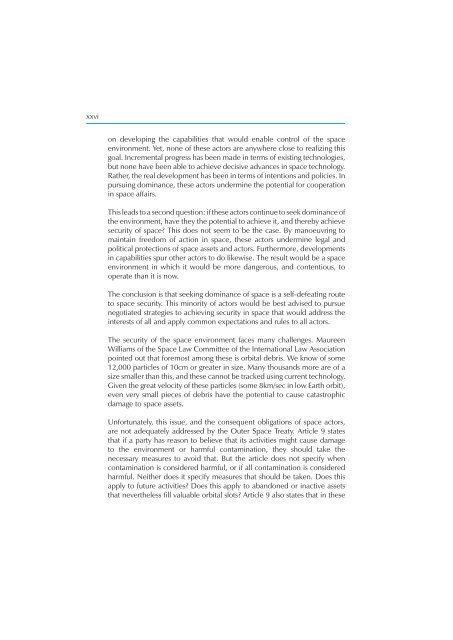Security in Space The Next Generation - UNIDIR
Security in Space The Next Generation - UNIDIR
Security in Space The Next Generation - UNIDIR
You also want an ePaper? Increase the reach of your titles
YUMPU automatically turns print PDFs into web optimized ePapers that Google loves.
xxvi<br />
on develop<strong>in</strong>g the capabilities that would enable control of the space<br />
environment. Yet, none of these actors are anywhere close to realiz<strong>in</strong>g this<br />
goal. Incremental progress has been made <strong>in</strong> terms of exist<strong>in</strong>g technologies,<br />
but none have been able to achieve decisive advances <strong>in</strong> space technology.<br />
Rather, the real development has been <strong>in</strong> terms of <strong>in</strong>tentions and policies. In<br />
pursu<strong>in</strong>g dom<strong>in</strong>ance, these actors underm<strong>in</strong>e the potential for cooperation<br />
<strong>in</strong> space affairs.<br />
This leads to a second question: if these actors cont<strong>in</strong>ue to seek dom<strong>in</strong>ance of<br />
the environment, have they the potential to achieve it, and thereby achieve<br />
security of space? This does not seem to be the case. By manoeuvr<strong>in</strong>g to<br />
ma<strong>in</strong>ta<strong>in</strong> freedom of action <strong>in</strong> space, these actors underm<strong>in</strong>e legal and<br />
political protections of space assets and actors. Furthermore, developments<br />
<strong>in</strong> capabilities spur other actors to do likewise. <strong>The</strong> result would be a space<br />
environment <strong>in</strong> which it would be more dangerous, and contentious, to<br />
operate than it is now.<br />
<strong>The</strong> conclusion is that seek<strong>in</strong>g dom<strong>in</strong>ance of space is a self-defeat<strong>in</strong>g route<br />
to space security. This m<strong>in</strong>ority of actors would be best advised to pursue<br />
negotiated strategies to achiev<strong>in</strong>g security <strong>in</strong> space that would address the<br />
<strong>in</strong>terests of all and apply common expectations and rules to all actors.<br />
<strong>The</strong> security of the space environment faces many challenges. Maureen<br />
Williams of the <strong>Space</strong> Law Committee of the International Law Association<br />
po<strong>in</strong>ted out that foremost among these is orbital debris. We know of some<br />
12,000 particles of 10cm or greater <strong>in</strong> size. Many thousands more are of a<br />
size smaller than this, and these cannot be tracked us<strong>in</strong>g current technology.<br />
Given the great velocity of these particles (some 8km/sec <strong>in</strong> low Earth orbit),<br />
even very small pieces of debris have the potential to cause catastrophic<br />
damage to space assets.<br />
Unfortunately, this issue, and the consequent obligations of space actors,<br />
are not adequately addressed by the Outer <strong>Space</strong> Treaty. Article 9 states<br />
that if a party has reason to believe that its activities might cause damage<br />
to the environment or harmful contam<strong>in</strong>ation, they should take the<br />
necessary measures to avoid that. But the article does not specify when<br />
contam<strong>in</strong>ation is considered harmful, or if all contam<strong>in</strong>ation is considered<br />
harmful. Neither does it specify measures that should be taken. Does this<br />
apply to future activities? Does this apply to abandoned or <strong>in</strong>active assets<br />
that nevertheless fi ll valuable orbital slots? Article 9 also states that <strong>in</strong> these








